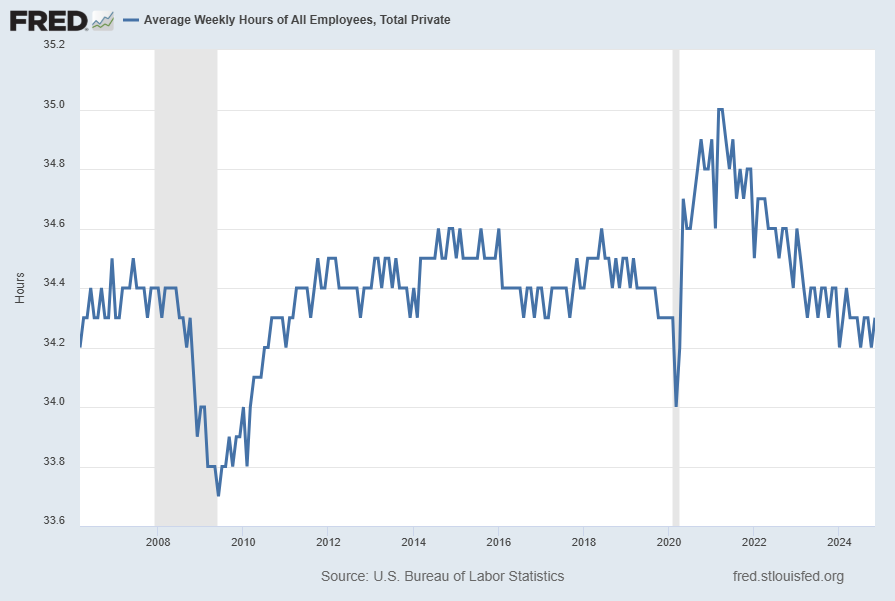Throughout this site there are many discussions of economic indicators. This post is the latest in a series of posts indicating facets of U.S. economic weakness or a notably low growth rate.
The level and trend of economic growth is especially notable at this time. As seen in various sources, recession estimates have been at elevated levels.
As seen in the October 2024 Wall Street Journal Economic Forecast Survey the consensus (average estimate) among various economists is for 2.21% GDP in 2024, 1.92% GDP in 2025, 2.15% GDP in 2026, and 2.13% in 2027.
Charts Indicating U.S. Economic Weakness
Below is a small sampling of charts that depict weak growth or contraction, and a brief comment for each:
All Employees, Temporary Help Services (TEMPHELPS)
I have written extensively about many facets of employment and unemployment, as the current and future unemployment issue is of tremendous importance yet is in many ways misunderstood.
One theory regarding employment is that hiring cycles typically begin with an uptake in temporary employment. Conversely, due to various factors a reduction in temporary employees can be an (early) indicator of lessening labor demand.
Shown below is this TEMPHELPS measure with last value of 2,646.3 (Thousands) through November, last updated December 6, 2024:

Below is this measure displayed on a “Percent Change From Year Ago” basis with value -5.0%:

source: U.S. Bureau of Labor Statistics, All Employees, Temporary Help Services [TEMPHELPS], retrieved from FRED, Federal Reserve Bank of St. Louis; accessed January 5, 2025: https://fred.stlouisfed.org/series/TEMPHELPS
__
Average Weekly Hours of All Employees, Total Private (AWHAETP)
Average Weekly Hours of All Employees, Total Private continues a significant downward progression. This “Average Weekly Hours” measure had a value of 34.3 (Hours) through November 2024 as of the December 6, 2025 update:

Below is this measure displayed on a “Percent Change From Year Ago” basis with value -.3%:

source: U.S. Bureau of Labor Statistics, Average Weekly Hours of All Employees, Total Private [AWHAETP], retrieved from FRED, Federal Reserve Bank of St. Louis; accessed January 5, 2025: https://fred.stlouisfed.org/series/AWHAETP
__
Employment-Population Ratio For 25-54 Yrs (LNS12300060)
The Employment-Population Ratio For 25-54 years measure appears to have peaked and is now declining on a “Percent Change From Year Ago” basis. This “Employment-Population Ratio” measure had a value of 80.4 Percent through November 2024 as of the December 6, 2024 update:

Below is this measure displayed on a “Percent Change From Year Ago” basis with value -.4%:

source: U.S. Bureau of Labor Statistics, Employment-Population Ratio – 25-54 Yrs. [LNS12300060], retrieved from FRED, Federal Reserve Bank of St. Louis; accessed January 5, 2025: https://fred.stlouisfed.org/series/LNS12300060
__
Truck Tonnage (TRUCKD11)
Truck Tonnage (TRUCKD11) has yet to reach its pre-pandemic peak, and has since been faltering. Shown below is this measure with last value of 113.9 through October, last updated December 11, 2024:

Below is this measure displayed on a “Percent Change From Year Ago” basis with value -.3%:

source: U.S. Bureau of Transportation Statistics, Truck Tonnage Index [TRUCKD11], retrieved from FRED, Federal Reserve Bank of St. Louis; accessed January 6, 2025: https://fred.stlouisfed.org/series/TRUCKD11
__
Other Indicators
As mentioned previously, many other indicators discussed on this site indicate weak economic growth or economic contraction, if not outright (gravely) problematical economic conditions.
_____
The Special Note summarizes my overall thoughts about our economic situation
SPX at 5942.47 as this post is written
No comments:
Post a Comment